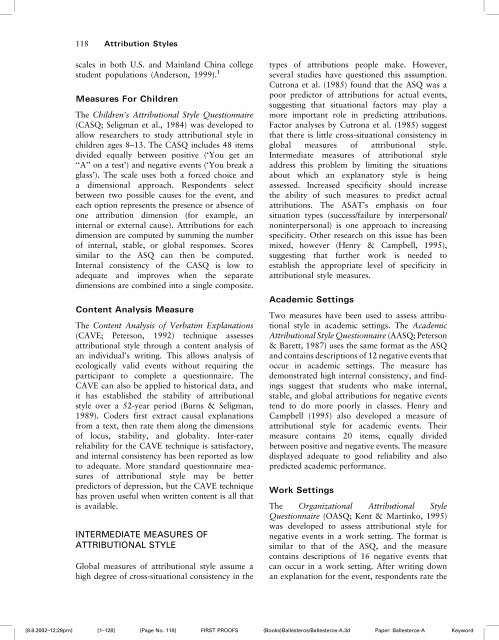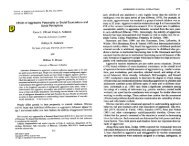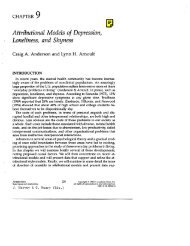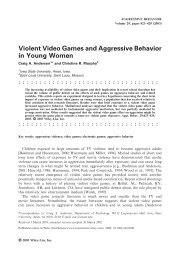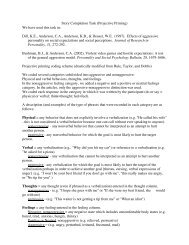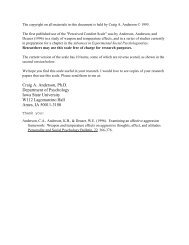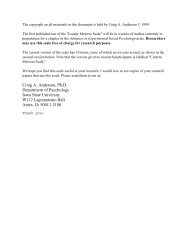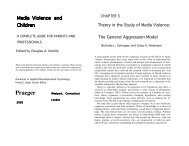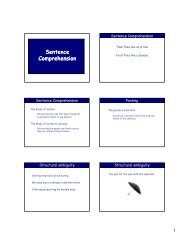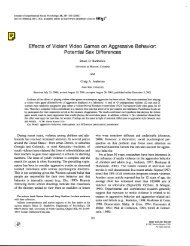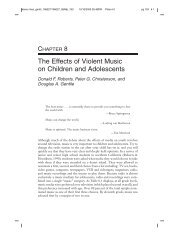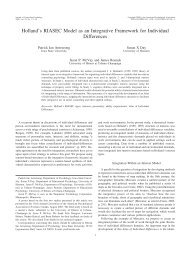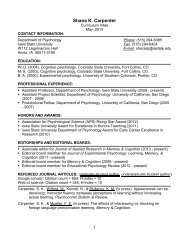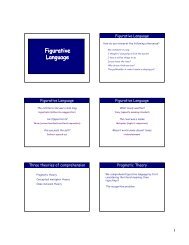Measures of attributional style
Measures of attributional style
Measures of attributional style
You also want an ePaper? Increase the reach of your titles
YUMPU automatically turns print PDFs into web optimized ePapers that Google loves.
118 Attribution Styles<br />
scales in both U.S. and Mainland China college<br />
student populations (Anderson, 1999). 1<br />
<strong>Measures</strong> For Children<br />
The Children’s Attributional Style Questionnaire<br />
(CASQ; Seligman et al., 1984) was developed to<br />
allow researchers to study <strong>attributional</strong> <strong>style</strong> in<br />
children ages 8–13. The CASQ includes 48 items<br />
divided equally between positive (‘You get an<br />
‘‘A’’ on a test’) and negative events (‘You break a<br />
glass’). The scale uses both a forced choice and<br />
a dimensional approach. Respondents select<br />
between two possible causes for the event, and<br />
each option represents the presence or absence <strong>of</strong><br />
one attribution dimension (for example, an<br />
internal or external cause). Attributions for each<br />
dimension are computed by summing the number<br />
<strong>of</strong> internal, stable, or global responses. Scores<br />
similar to the ASQ can then be computed.<br />
Internal consistency <strong>of</strong> the CASQ is low to<br />
adequate and improves when the separate<br />
dimensions are combined into a single composite.<br />
Content Analysis Measure<br />
The Content Analysis <strong>of</strong> Verbatim Explanations<br />
(CAVE; Peterson, 1992) technique assesses<br />
<strong>attributional</strong> <strong>style</strong> through a content analysis <strong>of</strong><br />
an individual’s writing. This allows analysis <strong>of</strong><br />
ecologically valid events without requiring the<br />
participant to complete a questionnaire. The<br />
CAVE can also be applied to historical data, and<br />
it has established the stability <strong>of</strong> <strong>attributional</strong><br />
<strong>style</strong> over a 52-year period (Burns & Seligman,<br />
1989). Coders first extract causal explanations<br />
from a text, then rate them along the dimensions<br />
<strong>of</strong> locus, stability, and globality. Inter-rater<br />
reliability for the CAVE technique is satisfactory,<br />
and internal consistency has been reported as low<br />
to adequate. More standard questionnaire measures<br />
<strong>of</strong> <strong>attributional</strong> <strong>style</strong> may be better<br />
predictors <strong>of</strong> depression, but the CAVE technique<br />
has proven useful when written content is all that<br />
is available.<br />
INTERMEDIATE MEASURES OF<br />
ATTRIBUTIONAL STYLE<br />
Global measures <strong>of</strong> <strong>attributional</strong> <strong>style</strong> assume a<br />
high degree <strong>of</strong> cross-situational consistency in the<br />
types <strong>of</strong> attributions people make. However,<br />
several studies have questioned this assumption.<br />
Cutrona et al. (1985) found that the ASQ was a<br />
poor predictor <strong>of</strong> attributions for actual events,<br />
suggesting that situational factors may play a<br />
more important role in predicting attributions.<br />
Factor analyses by Cutrona et al. (1985) suggest<br />
that there is little cross-situational consistency in<br />
global measures <strong>of</strong> <strong>attributional</strong> <strong>style</strong>.<br />
Intermediate measures <strong>of</strong> <strong>attributional</strong> <strong>style</strong><br />
address this problem by limiting the situations<br />
about which an explanatory <strong>style</strong> is being<br />
assessed. Increased specificity should increase<br />
the ability <strong>of</strong> such measures to predict actual<br />
attributions. The ASAT’s emphasis on four<br />
situation types (success/failure by interpersonal/<br />
noninterpersonal) is one approach to increasing<br />
specificity. Other research on this issue has been<br />
mixed, however (Henry & Campbell, 1995),<br />
suggesting that further work is needed to<br />
establish the appropriate level <strong>of</strong> specificity in<br />
<strong>attributional</strong> <strong>style</strong> measures.<br />
Academic Settings<br />
Two measures have been used to assess <strong>attributional</strong><br />
<strong>style</strong> in academic settings. The Academic<br />
Attributional Style Questionnaire (AASQ; Peterson<br />
& Barett, 1987) uses the same format as the ASQ<br />
and contains descriptions <strong>of</strong> 12 negative events that<br />
occur in academic settings. The measure has<br />
demonstrated high internal consistency, and findings<br />
suggest that students who make internal,<br />
stable, and global attributions for negative events<br />
tend to do more poorly in classes. Henry and<br />
Campbell (1995) also developed a measure <strong>of</strong><br />
<strong>attributional</strong> <strong>style</strong> for academic events. Their<br />
measure contains 20 items, equally divided<br />
between positive and negative events. The measure<br />
displayed adequate to good reliability and also<br />
predicted academic performance.<br />
Work Settings<br />
The Organizational Attributional Style<br />
Questionnaire (OASQ; Kent & Martinko, 1995)<br />
was developed to assess <strong>attributional</strong> <strong>style</strong> for<br />
negative events in a work setting. The format is<br />
similar to that <strong>of</strong> the ASQ, and the measure<br />
contains descriptions <strong>of</strong> 16 negative events that<br />
can occur in a work setting. After writing down<br />
an explanation for the event, respondents rate the<br />
[8.8.2002–12:29pm] [1–128] [Page No. 118] FIRST PROOFS {Books}Ballesteros/Ballesteros-A.3d Paper: Ballesteros-A Keyword


